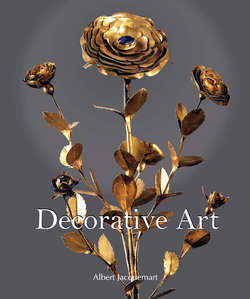Читать книгу Decorative Art - Albert Jacquemart - Страница 8
На сайте Литреса книга снята с продажи.
Furniture
Furniture styled with brass carving
ОглавлениеTo remove the natural gloomy appearance of ebony and give it the lustre we like to see combined with ornament, it sufficed to relieve it with the application of chiselled bronze coated over with a warm and solid gilding called ormolu. The cabinet makers of the 17th century did this, and from that time the chiselling of bronze became an important trade and one of the principal specialities of furniture. Frames with masks and palmettes, mouldings cut in delicate ornamentation, mythological bas-reliefs, statuettes introduced as appendages, were combined with those designs which, at first simple, and then by degrees more and more complicated, inertly led from the reign of Louis XIII to the exaggerated style of the Regency.
But this is no argument that ebony furniture with gilt metal mountings was frequent. Quite the contrary; it constitutes one of those curious transitions which show a search after some unknown idea not yet discovered. It is no longer the carved and engraved furniture acknowledged as too severe, nor is it that which in its dazzling elegance was to find its place in the palaces of Louis XIV. Also there is no doubt that conjointly with the plating of Boulle, ebony with gilded bronze would be found at a later period in the dwellings of serious-looking magistrates or Jansenists living according to austere morals.
Moreover, the search for a new, and still undetermined, form is manifested here and in many cases ebony disappears to make way for more coy marquetry. Large surfaces have a border in which the fibres are arranged perpendicularly to the lines of the outer edge, the panels show the wood divided into four parts and arranged in opposition to each other in a herringbone fashion, which means the slanting fibres form a chevron at the point of junction in the centre. This provision will grow much more in the veneered marquetry of different woods, which we will discuss later.
This change in workmanship and style coincides with a radical modification in furnishing which is about to strike boldly into the modern path. Ebony inlaid with brass is used in bouts de bureaux, a species of closed secretaire with drawers and pigeon-holes, surmounted by a clock with figures often of very fine workmanship. At the same time clocks make their appearance on pedestals, book-cases and monumental armoires arise in imposing bulk with pilasters and arched headings. Commodes with drawers are soon substituted for the pieces of furniture derived from the cabinet, with the lower part closed by double doors, beneath which appear a species of drawers sliding on inner grooves. This style, as we see, is entirely a style of transition and often exhibits the same arrangement as the Boulle furniture.
The most remarkable bout de bureau we have ever seen is that belonging to Gustave de Rothschild, which appeared at the Exhibition for the benefit of Alsace and Lorraine. The lower part, rectangular and open on the sides, bore on its front a trophy of musical instruments tied by ribbons, and on the sides masks crowned with palmettes and acanthus leaves in gilt metal. The upper part, narrower at the top with two folding doors ornamented with palmette crowned masks, was united to the base by arched flowerings falling back in a fretwork against their bases. Brackets projected from the recesses to serve as support for the athletes bearing coiled scrolls. The piece is crowned by an allegorical bronze, which is partly gilt and partly tinted with a brown patina; on a mass of clouds traversed by the scythe of time appears a winged globe, half covered by a veil and encircled by a serpent. The hours are marked upon it and a genie points to them, while another genie, surrounded by symbols of the sciences and seated on the clouds, is writing in a book he holds. The clock is signed, “Stollewerck, à Paris”.
This evidently belongs to the 17th century and it seems impossible to determine more than this with certainty. It is very difficult, as we said before, to circumscribe different pieces of furniture within exact limits and define the period in which each type should begin and end. In the case of ebony with brass, a mixed and undetermined style, a scrupulous observation of the general form and the workmanship of the metal may furnish indications, which must, however, be accepted with caution. The different styles did not succeed each other suddenly and radically as fashions at that time were not as imperious as now. Therefore, industry could produce kinds, which we should feel inclined to extend over a widely graduated scale, at the same time, and traditions were frequently preserved with the succeeding fashions. Thus, in the time of Louis XV, we still find ebony with bronze chasings in perfect taste.
Pair of armchairs with curved-backs and medallion-adorned frames, 18th century. Gilded wood, silk.
